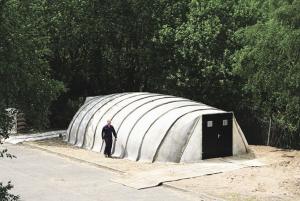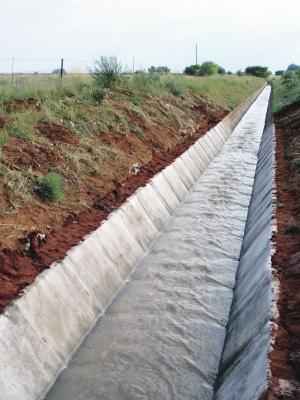Just Add Water: "Concrete Cloth"
Concrete Cloth™ is a flexible, cement-impregnated fabric that hardens when it’s hydrated with water to form a thin, durable, waterproof and fire resistant concrete layer. Milliken & Company of Spartanburg, S.C. started marketing the product in 2011. In the United Kingdom, where it was invented, the product is called Concrete Canvas™.
Milliken’s Concrete Cloth representative Rich Pilston says, “This product has applications in agriculture, construction, mining, horticulture and the pipeline industry.” It has been used extensively to line irrigation ditches in South Africa. “For many applications, Concrete Cloth provides the protective qualities of concrete at a fraction of the cost,” Pilston says.
Concrete Cloth is a 3-dimensionsal fiber matrix embedded with a specially formulated concrete mix. It has a waterproof pvc backing. After it’s laid in place, it can be hydrated either by spraying or by being fully immersed in water. There is no product to mix or measure and the product can’t be over hydrated. After it’s moistened, Concrete Cloth remains workable for 2 hrs. It hardens to 80 percent of its final strength in 24 hrs., and is 100 percent cured within a week.
The product is manufactured in 5, 8 or 13 mm thicknesses. Material is packaged in rolls that are about 4 ft. wide. Rolls of the 5 mm thick material weigh about 165 lbs. and cover 100 sq. ft. Large commercial rolls are also available. Prices range from $5 to $10 per sq. ft.
Pilston says, “Concrete Cloth is a strong, versatile and environmentally friendly product. It uses up to 95 percent less in materials than conventional concrete for many applications, and has low impact on the environment due to limited alkaline and a low wash rate.”
In agricultural applications Concrete Cloth can be unrolled to form a ditch or a tank lining. A small overlap creates a tough seam. After it’s hydrated and cured, the material forms a protective layer that’s waterproof and chemical proof. It’s ideal for stabilizing slopes, protecting stream banks, creating custom decorative panels, inhibiting weeds around culverts, and creating a flood fence.
Concrete Cloth is flexible and easy to install. It can be hung vertically, laid in trenches or cut and formed into shapes to create a durable layer of concrete, all without the need for molds or mixing. It can be installed in the rain or in wet conditions. The product meets ASTM and other building standards and resists chemicals, weather and UV rays.
Concrete Canvas Ltd. in the UK produces pre-packaged shelters that use the product. They can be set up and hydrated in a few hours. A large fan inflates the shelter like a sleeping bag and then the exterior is sprayed with water to activate the concrete. Within 24 hours the shelter is ready to use. Access holes can be cut for doors or windows. The interior and exterior are completely waterproof and fire resistant. The exterior resists abrasion and punctures and withstands freeze-thaw cycles. The shelters are available directly from the manufacturer.
Contact: FARM SHOW Followup, Rich Pilston, Concrete Cloth Business Development Manager, Milliken & Company, 920 Milliken Rd., Spartanburg, S.C. 29304 (ph 864 503-2020; concretecloth@milliken.com; www.concretecloth.milliken.com).

Click here to download page story appeared in.
Click here to read entire issue
Just Add Water: Concrete Cloth FARM HOME Miscellaneous Concrete Cloth™ is a flexible cement-impregnated fabric that hardens when it’s hydrated with water to form a thin durable waterproof and fire resistant concrete layer Milliken & Company of Spartanburg S C started marketing the product in 2011 In the United Kingdom where it was invented the product is called Concrete Canvas™ Milliken’s Concrete Cloth representative Rich Pilston says “This product has applications in agriculture construction mining horticulture and the pipeline industry ” It has been used extensively to line irrigation ditches in South Africa “For many applications Concrete Cloth provides the protective qualities of concrete at a fraction of the cost ” Pilston says Concrete Cloth is a 3-dimensionsal fiber matrix embedded with a specially formulated concrete mix It has a waterproof pvc backing After it’s laid in place it can be hydrated either by spraying or by being fully immersed in water There is no product to mix or measure and the product can’t be over hydrated After it’s moistened Concrete Cloth remains workable for 2 hrs It hardens to 80 percent of its final strength in 24 hrs and is 100 percent cured within a week The product is manufactured in 5 8 or 13 mm thicknesses Material is packaged in rolls that are about 4 ft wide Rolls of the 5 mm thick material weigh about 165 lbs and cover 100 sq ft Large commercial rolls are also available Prices range from $5 to $10 per sq ft Pilston says “Concrete Cloth is a strong versatile and environmentally friendly product It uses up to 95 percent less in materials than conventional concrete for many applications and has low impact on the environment due to limited alkaline and a low wash rate ” In agricultural applications Concrete Cloth can be unrolled to form a ditch or a tank lining A small overlap creates a tough seam After it’s hydrated and cured the material forms a protective layer that’s waterproof and chemical proof It’s ideal for stabilizing slopes protecting stream banks creating custom decorative panels inhibiting weeds around culverts and creating a flood fence Concrete Cloth is flexible and easy to install It can be hung vertically laid in trenches or cut and formed into shapes to create a durable layer of concrete all without the need for molds or mixing It can be installed in the rain or in wet conditions The product meets ASTM and other building standards and resists chemicals weather and UV rays Concrete Canvas Ltd in the UK produces pre-packaged shelters that use the product They can be set up and hydrated in a few hours A large fan inflates the shelter like a sleeping bag and then the exterior is sprayed with water to activate the concrete Within 24 hours the shelter is ready to use Access holes can be cut for doors or windows The interior and exterior are completely waterproof and fire resistant The exterior resists abrasion and punctures and withstands freeze-thaw cycles The shelters are available directly from the manufacturer Contact: FARM SHOW Followup Rich Pilston Concrete Cloth Business Development Manager Milliken & Company 920 Milliken Rd Spartanburg S C 29304 ph 864 503-2020; concretecloth@milliken com; www concretecloth milliken com
To read the rest of this story, download this issue below or click
here to register with your account number.








